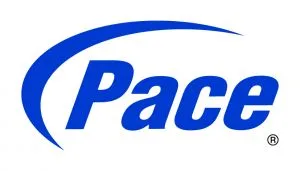This week, in the LDM, we have a supplement on the developments at the NAB show. Chris clearly had an interesting time there and there was lots of activity in UltraHD and Super Hi-Vision, in HDR, in 360 degree cameras for VR content creation and small pitch LEDs. Combined with his report on the SMPTE conference last week, it gives a good update on the state of the industry. Next week, we will be in London for the TV Connect show which will cover European broadcasting and OTT content.
A Look Back at Pace
By Bob Raikes

Big news, but which arrived late, was of the sale of Pace to Arris. Pace had been an early developer of cable modems since its founding back in 1982. In the ’90s, Display Monitor was mainly focused on the IT markets, rather than TV, so we didn’t cover the company regularly until the end of the decade, when the company was already well established as a supplier of STBs, especially in Europe, where it was a pioneer of technology such as DVB-T and DVB-S.
The “noughties” were a very up and down decade for the company. In 2006, the company had four consecutive profit warning quarters, lost money and had to restructure and change much of its management team. There was genuine concern over the future of the company at that time, but a delayed US contract came in and it started to make its way back. It was the eighth biggest STB maker globally.
In 2008, Pace acquired the STB business of Philips and that really helped the company to develop the scale needed to be competitive. In 2008, it sold around 13 million STBs to get into the top three STB makers.
In 2009, Philips sold a significant stake that it had in Pace, valuing the company at that time at around €450 million. At the time, that sale seemed a good move, but the wonder of 20/20 rear-view vision allows us to see that as perhaps not the best move, in the light of this week’s deal. In the same year, the firm went past Technicolor to become the second biggest STB maker, behind Motorola.
By 2010, Pace was claiming to be the top supplier of STBs for Pay TV and had a strong position in the developing PVR market. Pace bought 2Wire, Bewan and Latens as it looked at other functions, beyond video, that a home gateway or STB could perform as service providers started to look at widening the services that they could offer.
The strong position in PVRs turned out to be not such a great advantage when the floods in Thailand in early 2011 caused a shortage of hard disks that impacted STB makers badly and there were more profit warnings. Later that year, Google bought the Motorola Mobility business which included the STB business, although the mobile technology that Motorola had seemed to be the main driver for the deal.
2012 saw Pace making a bid for the Motorola business, but the winner of that battle was Arris, which has now cemented its position as the clear top maker of STBs. At the time, we reported that the STB businesses of Pace, Cisco and Technicolor were also available for sale as makers looked warily at the potential impact of OTT services.
In one way, it is disappointing to see Pace, an unusual company as a significant UK consumer electronics company, become part of a US group. However, the most recent data from the company shows that revenues for the firm were almost twice as much ($937 million) in North America as in the rest of the world ($544 million) in the second half of 2014 and it is good to see a company that has been made attractive enough to acquire.
We expect to hear more about the deal at the TV Connect show next week.
Bob
